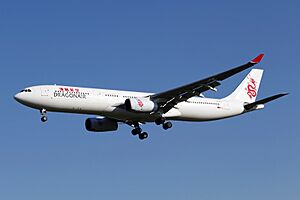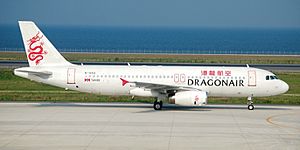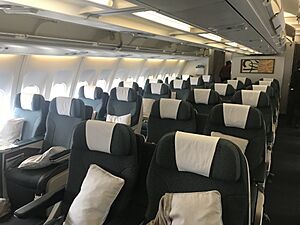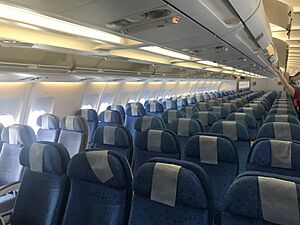Cathay Dragon facts for kids
 |
|
| Founded | 24 May 1985 (as Dragonair) |
|---|---|
| Commenced operations |
|
| Ceased operations | 21 October 2020 (merged into Cathay Pacific) |
| Hubs |
|
| Frequent-flyer program |
|
| Alliance | Oneworld (affiliate; 2007–2020) |
| Parent company | Cathay Pacific |
| Headquarters | Cathay Dragon House, Hong Kong International Airport, Chek Lap Kok, Hong Kong |
| Key people | |
| Cathay Dragon | |||||||||||||||
|---|---|---|---|---|---|---|---|---|---|---|---|---|---|---|---|
| Traditional Chinese | 國泰港龍航空 | ||||||||||||||
| Simplified Chinese | 国泰港龙航空 | ||||||||||||||
| Cantonese Yale | Gwoktaai Gónglùng Hònghūng | ||||||||||||||
|
|||||||||||||||
Cathay Dragon was an airline based in Hong Kong. It was also known as Dragonair until 2016. Its main base was at Hong Kong International Airport.
Before it stopped flying, Cathay Dragon flew to about 50 places. These were in 14 different countries and areas across Asia. The airline also shared flights with other airlines. It used 35 Airbus planes, including A320s, A321s, and A330s.
Cathay Dragon was fully owned by Cathay Pacific, which is Hong Kong's main airline. It was also part of the Oneworld airline group. The airline started on May 24, 1985. It was founded by Chao Kuang Piu. Its first flight went from Hong Kong to Kota Kinabalu, Malaysia, in July 1985. In 2010, Cathay Dragon and Cathay Pacific together flew over 138,000 flights. They carried almost 27 million passengers. They also moved over 1.8 billion kg of cargo and mail.
Contents
What Was Cathay Dragon's History?
How Did Dragonair Start?
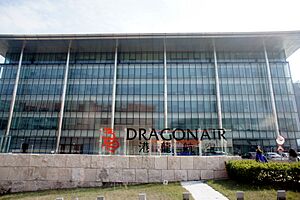
Dragonair began in Hong Kong on May 24, 1985. It was started by Chao Kuang Piu. The airline began flying in July 1985. Its first flight was from Kai Tak Airport to Kota Kinabalu International Airport in Malaysia.
In 1986, Dragonair started flying to Phuket International Airport in Thailand. It also flew to six cities in mainland China. In 1987, it became the first Hong Kong airline to join International Air Transport Association (IATA).
Dragonair was the first new local airline to compete with Cathay Pacific in 40 years. Cathay Pacific tried hard to stop Dragonair from getting flight slots. In 1987, the Hong Kong government decided on a "one-route-one-airline" rule. This made it hard for Dragonair to get the routes it needed.
Stephen Miller, Dragonair's first CEO, said Cathay Pacific was not happy about their arrival. Cathay Pacific focused on other travel markets. This left the undeveloped mainland China market to Dragonair. So, Dragonair focused on flying to mainland China.
What Happened in the 1990s?
In January 1990, Cathay Pacific and other companies bought most of Dragonair. Cathay Pacific then gave its Beijing and Shanghai routes to Dragonair. They also leased a Lockheed L-1011 TriStar plane to Dragonair.
The first Airbus A320 joined Dragonair's fleet in March 1993. By December, they had six A320 planes. In July 1995, the Airbus A330 also joined Dragonair's fleet.
In April 1996, China National Aviation Corporation bought more shares. They became the biggest owner of Dragonair. On July 5, 1998, Dragonair Flight 841 was the last scheduled flight to land at Kai Tak Airport.
How Did the Airline Grow?

In 2000, Dragonair started flying cargo to Shanghai, Europe, and the Middle East. They used a leased Boeing 747-200 cargo plane. In May 2001, they added cargo flights to Osaka.
The airline bought two Boeing 747-300 cargo planes in 2001. They expanded cargo flights to Xiamen and Taipei in 2002. Cargo flights made up 30 percent of their income in 2002.
All regular flights became scheduled services in March 2000. Passenger flights to Taipei, Bangkok, and Tokyo started in 2002, 2003, and 2004. Dragonair Cargo kept growing. By mid-2004, the airline had five Boeing 747 cargo planes. They also had 26 Airbus passenger planes.
Dragonair planned to start passenger flights to Sydney in 2005. They also planned flights to Manila and Seoul. The airline also wanted to fly cargo to the United States in 2005. They planned to have nine Boeing 747 cargo planes by 2008.
Cathay Pacific Takes Over
By 2005, Cathay Pacific owned 18 percent of Dragonair. Other companies owned the rest. In March 2005, there were talks about Cathay Pacific taking over Dragonair. But Cathay Pacific said they had no such plans.
On September 28, 2006, Dragonair became fully owned by Cathay Pacific. Cathay Pacific said Dragonair would still fly as a separate airline. It would keep its own license and brand. However, some staff were moved or let go.
By 2009, Dragonair's flights to Bangkok and Tokyo were stopped. Cathay Pacific took over these routes. Also, the plan for nine cargo planes was cancelled. Three Boeing 747-400BCF cargo planes were moved to Cathay Pacific.
On June 7, 2010, Dragonair got its first used Airbus A330-300 from Cathay Pacific. This was to replace their leased A330s.
Working Closer with Cathay Pacific
Dragonair's own loyalty program, The Elite, joined Cathay Pacific's Marco Polo Club in 2007. On August 1, 2007, the airline opened a shared office with Cathay Pacific in Beijing. Dragonair also joined the Oneworld alliance on November 1, 2007. Cathay Pacific was a founding member of Oneworld.
On October 1, 2008, they opened their first airline-branded arrival lounge. It was called The Arrival at Hong Kong International Airport. Dragonair's ground handling company, HIAS, joined with Hong Kong Airport Services Ltd (HAS) in 2008. HAS became fully owned by Cathay Pacific in December 2008.
In January 2016, Cathay Pacific announced a name change. Dragonair would become Cathay Dragon. The new name became active on November 21, 2016.
Why Did Cathay Dragon Stop Flying?
On October 21, 2020, Cathay Pacific announced that Cathay Dragon would stop flying right away. This was part of a big change due to the COVID-19 pandemic. Most of the flight crew and staff at Cathay Dragon lost their jobs.
Where Did Cathay Dragon Fly?
Before it stopped flying, Cathay Dragon flew its own planes to 47 places. This included 22 cities in mainland China. All flights started from its home base in Hong Kong.
Cathay Dragon shared flights with these airlines:
- Air Canada
- Air China
- American Airlines
- Bangkok Airways
- Cathay Pacific
- Finnair
- Malaysia Airlines
- Qantas
- S7 Airlines
- Shenzhen Airlines
What Planes Did Cathay Dragon Use?
Final Fleet
Cathay Dragon used only Airbus planes. These included both smaller single-aisle planes and larger twin-aisle planes. Here are the planes they had before joining Cathay Pacific:
| Aircraft | In Service | Orders | Passengers | Notes | |||
|---|---|---|---|---|---|---|---|
| F | B | E | Total | ||||
| Airbus A320-200 | 10 | — | — | 8 | 156 | 164 | All planes were retired when the airline stopped flying. 3 planes were moved to Cathay Pacific. 8 planes were stored due to the COVID-19 pandemic. They were going to be replaced by Airbus A321neo. 3 planes still fly with Hong Kong Express. |
| Airbus A321-200 | 7 | — | — | 24 | 148 | 172 | 3 planes were retired when the airline stopped flying. 5 planes were moved to Cathay Pacific. 3 planes were stored due to the COVID-19 pandemic. 2 planes still fly with Hong Kong Express. |
| Airbus A321neo | — | 16 | — | 12 | 190 | 202 | Orders were moved to Cathay Pacific. They were meant to replace older A320s and A321s. |
| Airbus A330-300 | 18 | 2 | 8 | 42 | 230 | 280 | All planes were returned or moved to Cathay Pacific. |
| — | 42 | 265 | 307 | ||||
| — | 24 | 293 | 317 | ||||
| Total | 35 | 18 | |||||
Former Fleet
| Aircraft | Total | Year Introduced | Year Retired | Notes |
|---|---|---|---|---|
| Airbus A300B4-200F | Unknown | Unknown | Unknown | |
| Airbus A320-200 | 18 | 1993 | 2020 | Older planes were retired. |
| Airbus A321-200 | 1 | 1999 | 2020 | |
| Airbus A330-300 | 21 | 1995 | 2020 | Older planes were retired. Includes the world's first A330-300 (B-HLJ). 6 planes moved from Cathay Pacific. |
| Boeing 737-200 | 6 | 1985 | 1993 | |
| Boeing 747-200F | 1 | 2001 | 2009 | |
| Boeing 747-300SF | 3 | 2001 | 2010 | |
| Boeing 747-400BCF | 4 | 2006 | 2010 | Cargo planes from Cathay Pacific. |
| Lockheed L-1011 TriStar | 1 | 1990 | 1995 | |
| 2 | Leased from Cathay Pacific. |
What Did Cathay Dragon Planes Look Like?
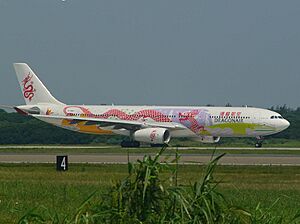
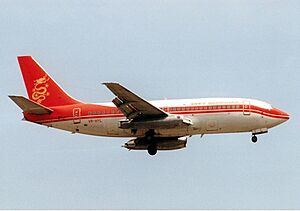
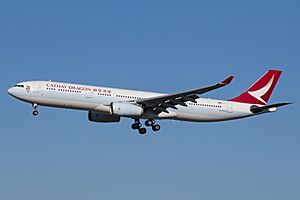
The airline's first design had a thick red stripe on a white plane body. The tail was also red. The airline's name and logo were in gold. They were on the front of the plane and on the tail.
The design before that was white with a red dragon. The dragon was on the engine covers and the tail. The airline's name was in red Chinese letters and black English letters.
On May 5, 2005, Dragonair celebrated its 20th birthday. They painted a special design on an Airbus A330-300. This design showed a water scene with a traditional Chinese boat. It also had fish jumping out of the water. A red dragon spread across the plane. Children played with lanterns by an old village. This design showed the airline's past and present.
On June 1, 2010, Dragonair celebrated its 25th birthday. They put another special design on an Airbus A330-300. It had the words "Serving you for 25 years." A golden dragon spread across the plane.
In 2016, Cathay Pacific changed Dragonair's name to Cathay Dragon. A new design was made for this change. It looks like Cathay Pacific's design but uses a light maroon color. The tail logo and font are similar. The plane says "Cathay Dragon" and has the Chinese name. The old Dragonair logo is still near the cockpit windows.
On June 1, 2017, Cathay Dragon got a special The Spirit of Hong Kong design. It was on an Airbus A330-300. This plane was retired on September 24, 2020.
Loyalty Programs
Cathay Dragon shared two loyalty programs with Cathay Pacific. These were The Marco Polo Club and Asia Miles. The Marco Polo Club was for loyal flyers. Asia Miles was a program where you could earn rewards for travel. If you were a member of The Marco Polo Club, you were also an Asia Miles member.
What Services Did Cathay Dragon Offer?
Food and drinks on flights from Hong Kong were made by LSG Lufthansa Services Hong Kong Ltd. This company was partly owned by Cathay Dragon. They served many local dishes on flights to mainland China. These included dim sum and barbecue pork with fried rice. However, on some shorter flights, only drinks and pastries were served in Economy Class.
The airline also offered many different newspapers and magazines. This included their own magazine, Emporium. Starting in March 2013, most of the planes got new seats. These new seats were like the ones on Cathay Pacific planes. The new design looked like Cathay Pacific's but had Chinese art. Seats in both Business and Economy Class had screens. These screens had movies, TV shows, and music. You could also charge your phone or other devices. All passengers had power outlets.
Awards
| Awards received by Cathay Dragon | |||||||||||||||||||||||||||||||||||||||||||||||||||||||||||||||||||||||||||||||||||||||
|---|---|---|---|---|---|---|---|---|---|---|---|---|---|---|---|---|---|---|---|---|---|---|---|---|---|---|---|---|---|---|---|---|---|---|---|---|---|---|---|---|---|---|---|---|---|---|---|---|---|---|---|---|---|---|---|---|---|---|---|---|---|---|---|---|---|---|---|---|---|---|---|---|---|---|---|---|---|---|---|---|---|---|---|---|---|---|---|
|
Subsidiaries and Partners
Since it started in 1985, the airline invested in companies that helped with airline services. These included companies for food, ground handling, and equipment.
Here are Cathay Dragon's main partners: (as of December 23, 2016)
- LSG Lufthansa Service Hong Kong Ltd – 31.94% owned
- Dah-Chong Hong-Dragonair Airport GSE Service Ltd (DAS) – 30%
- HAS GSE Solutions Ltd – 30%
Hong Kong Airport Services Ltd
Hong Kong Airport Services Ltd (HAS) helped Cathay Dragon at Hong Kong International Airport. They handled things like baggage, cargo, and ticketing. On November 1, 2008, HIAS joined with HAS. HAS became fully owned by Cathay Pacific on December 1, 2008.
See also
 In Spanish: Cathay Dragon para niños
In Spanish: Cathay Dragon para niños



